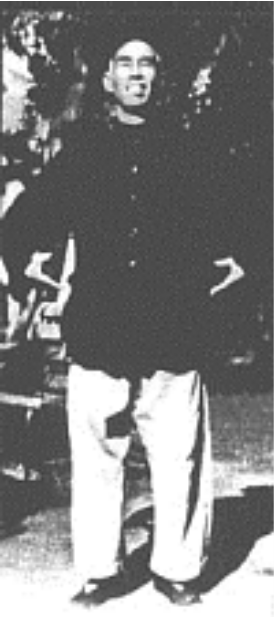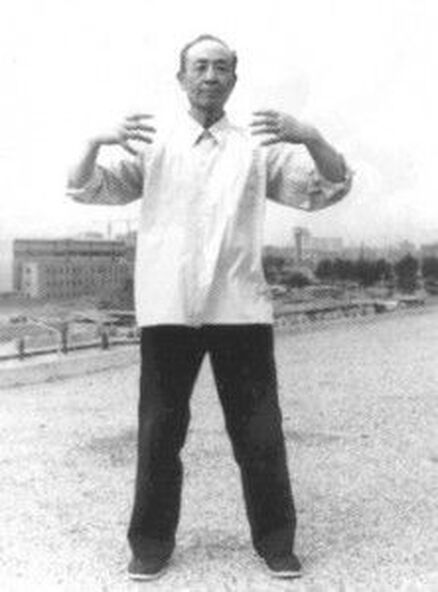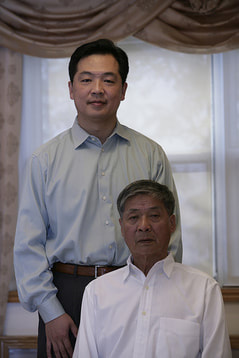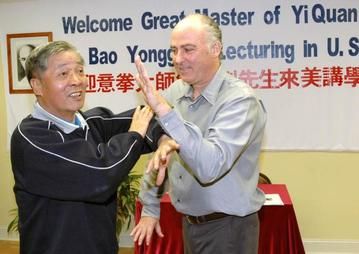 Wang Xiangzhai
Wang Xiangzhai
Qigong exercises are generally performed with relaxation and focus (in some instances, tension is consciously used for a specific purpose). The mindful movements of Qigong gently stretch the body and sinew channels to promote a balanced flow of qi. Proper practice also develops the resilience, whole body connectivity and flexibility of the fascial/connective tissue system. Qigong practicing can be more yin or nourishing, or more yang and energizing. Once you understand what you need for balance, you can use the appropriate type of Qigong to attain that. Scientific studies in China have shown that Qigong can catalyze increased blood flow right down to the capillary level. Practitioners know that consistent Qigong practice can build harmonious energy and a deep sense of centeredness.
** Qi meaning life force is very simplistic and limited. To begin a deeper understanding of "Qi", please read this: http://jaybulloch.com/articles/what-is-qi/ and start practicing Qigong or Taijiquan.
Qigong Resources and Videos
Common Mistakes in Qigong and Taijiquan Practice by Sifu Mark Rasmus
www.youtube.com/watch?v=CBvSMOD1OV8&t=127s
Sifu Mark Rasmus has hundreds of fascinating free videos on Youtube covering
Qigong, Taijiquan, Wing Chun, Hermetics, Healing and Meditation
Dealing with side effects in Qigong, Sifu Mark Rasmus:
www.youtube.com/watch?v=-AGfQ1koYn8
Eight Pieces of Brocade at Taoist Temple
www.youtube.com/watch?v=V6kNW504Jjs
please be careful with how far you stretch your neck....less is better for most
One of the Master's I learned Ba Duan Jin from :
www.youtube.com/watch?v=-XmD9K68Wwc
A quick and simple style of Qigong:
http://youtu.be/3zL4DyguWAk
More on Qigong self-healing-one approach:
https://www.youtube.com/watch?v=vXMSvxk0LRM
Another version of 8 pieces of the Brocade:
www.youtube.com/watch?v=445Fz8AQvX8
Recommended Books on Qigong:
A Comprehensive Guide to Daoist Nei Gong by Damo Mitchell
Decoding the Dao by Tom Bisio
Opening the Energy Gates of the Body by Bruce Frantzis
Heal Yourself with Qigong by Suzanne Friedman
Restoring Your Life Energy by Waysun Liao
The Master Key by Robert Peng
Meridian Massage by Cindy Black
Qigong websites:
http://www.qi-journal.com/index.asp
Qigong Meditations:
http://www.neiyanggong.us/jing-gong.html
Qi Magazine free download:
http://www.qimagazine.com/qimagazine00.html
Comprehensive site about Traditional Chinese Medicine:
http://www.shen-nong.com/eng/front/index.html
Acupressure points: Locations, uses and charts, http://www.yinyanghouse.com/
What is Yiquan?
Yiquan is a powerful martial, health and spiritual art which uses standing meditation for its foundation. These practices were found to rapidly build total well being, proper structure and internal power. Our classes feature these standing meditations for well-being, known as "Zhan Zhuang" or "post standing", along with slow motion drills or "shili" and stepping methods. A primary aim is the expansion and realization of Awareness creating the integration of body and mind with deeper levels of attention, will and intention. These skills can be used in martial arts or other life pursuits. Yiquan can reveal how to be natural in an unnatural world, how to stop fighting yourself on all levels and how to liberate your intrinsic power and talent. As a martial art, Yiquan training requires great perseverance, deep understanding and careful step by step cultivation of mind, body and spirit.
“Yi” (pronounced “ee”), refers to the concentration of mind and intention but in Yiquan it refers to something between "attention" and "intention". “Quan” (pronounced “chwen”), means fist or force in martial arts. Yiquan is a profound and unique art because of its focus on mind, intention and Zen like “emptiness” awareness combined with detailed physical training. Wang Xiangzhai created Yiquan and quickly established it as a formidable martial art. Later in life, he turned his attention to the use of Yiquan for health and conducted systematic research on Yiquan’s application for a variety of ailments with great success. This aspect of Yiquan, known as Zhan Zhuang, soon gained widespread use as a form of medical Qigong. Numerous scientific studies in China attest to its amazing health building abilities without creating any negative side effects. This research contributed to the widespread acceptance and practice of Qigong in China.
English translation of Wang Xiangzhai's "The Correct Path of Yiquan"
https://brennantranslation.wordpress.com/2016/08/31/the-correct-path-of-yiquan/
YIQUAN VIDEOS
Shifu Wei Yuzhu demonstrating Yiquan's "Hold the Tiger" and "Flying Dragon"
www.youtube.com/watch?v=XQJIRHyKBWk
Introduction to Yiquan in English, his site has more in-depth information
www.youtube.com/watch?v=hG1jwVxUKiE
Master Cui Ruibin- Yiquan's effect on the Cells
https://www.youtube.com/watch?v=aU5nrT2dEEk
Yiquan "Zhan Zhuang" program by Master Lam
https://www.youtube.com/watch?v=y07FauHYlmg&list=PLnbdKqPj9CY6iVtRrXg_Vjf07oozW6H5o
Master Yao Zongxun demonstrates Yiquan and Zhan Zhuang in the videos below:
http://www.youtube.com/watch?v=yeQ76vOOq5k&feature=bf_next&list=PL52FF6B9246236BF6&lf=results_main
http://www.youtube.com/watch?v=fOjct-3pFm8&list=PL52FF6B9246236BF6
Yiquan's Jianwu or "Health Dance" by Yao Zongxun:
http://www.youtube.com/watch?v=iKEpsJUBnqE&list=PL52FF6B9246236BF6
Yiquan Masters
www.youtube.com/channel/UCJW2UjNOpy0qDqPeBwskj3Q
Master Yao Zongxun


